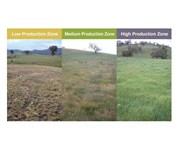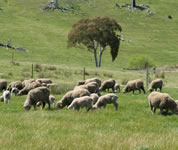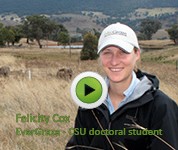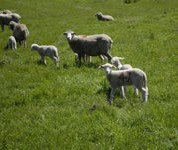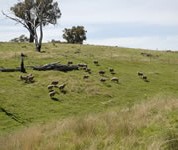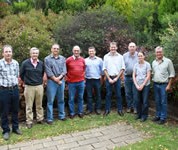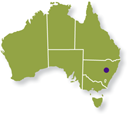Key Results
Click on the key result heading to see full information.
Production zone differences
- At Panuara, the Orange EverGraze Proof Site, it was demonstrated that the landscape could be mapped based on indicators of production capacity so that precision management decisions such as fencing location and fertiliser application could be made, resulting in efficient use of inputs and management of environmental risks.
- Soil water holding capacity was strongly influenced by production zone. The High Production Zone (HPZ) was able to store an extra 30% more soil water in the root zone than the Low Production Zone (LPZ), and this meant that it took longer to deplete, giving a longer period of pasture growth and consequently higher production. The greater water holding capacity in the HPZ was due to deeper top soil and less gravel.
- Pasture composition was strongly influenced by position in the landscape. Higher quality species such as Microlaena (Microlaena stipoides) and sub clover (Trifolium subterranean) were more prevalent on the lower slopes or HPZ, while the upper slopes or LPZ were dominated by wallaby grass (Rytidosperma spp., formally called Austrodanthonia spp.) and had a much lower production potential.
- Traditional application of superphosphate evenly spread across the whole paddock meant that before the experiment began, all production zones were treated equally. A soil survey showed the legacy of this approach, particularly phosphorus levels increased from the HPZ to the LPZ, indicating previously applied fertiliser had not been utilised in the LPZ due to lower water holding capacity and subsequent low pasture production.
- Pasture production was strongly influenced by production zone. Annual pasture production was 9.9, 6.1 and 4.6 tonnes dry matter per hectare (DM/ha) for the HPZ, Medium Production Zones (MPZ) and LPZ respectively.
Grazing system and seasonal influences on pasture composition
- The proportion of native grasses increased across all grazing treatments from 27% to 70% in response to rest and late spring rains in the year prior to the experiment. There was no further increase of total native grass composition throughout the experiment. However, the basal cover of Microlaena significantly increased (4% to 8%) following a wet summer in 2010.
- There were few significant differences in the composition change of native perennial grass species between grazing systems (1-Paddock vs 4-Paddock vs 20-Paddock). Any differences were generally short-term or seasonal.
- Ground cover on average was higher in the 20-Paddock than the 1-Paddock and 4-Paddock systems, although the overall difference was small. The difference between systems was greatest in summer and autumn when there was a feed deficit (feed demand was greater than pasture growth). Flexible stocking rates prevented ground cover from degrading below the 80% target in any system.
- There was greater herbage mass of annual ryegrass (Lolium rigidum) in the 20-Paddock than the 1-Paddock each spring. Less annual ryegrass in the 1-Paddock was probably due to the increased selective grazing in this system.
- Although compositional differences between treatments was not evident in the three years of this study, the systems needed to be run over a longer period of time to determine whether there are cumulative effects of management on nutrient cycling, and to allow a greater range of seasonal conditions for plants to respond to management.
Grazing system, production and economics
- Average green feed on offer (FOO) in the 20-Paddock rotation was often higher than the lower intensity 4-Paddock rotation and 1-Paddock set stocked system.
- On average, stocking rate increased with grazing intensity in response to higher FOO between 2009 and 2011 (average 1-Paddock = 6.0 DSE/ha, 4-Paddock = 6.5 DSE/ha, 20-Paddock = 7.8 DSE/ha).
- Dietary quality, measured by organic matter digestibility (OMD), was higher for ewes grazing the 1-Paddock compared to 4-Paddock and 20-Paddock systems. This resulted in higher average weaning weight of lambs in the 1-Paddock system (33.3 kg) compared to the 4-Paddock (31.1 kg) and 20-Paddock (29.8 kg) systems.
- Higher ewe condition score was found in the 1-Paddock than the 4-Paddock and 20-Paddock systems. The condition score was substantially higher from spring 2009, but differences were still evident when stocking rates were the same in 2008. On average all systems had a higher condition score than the Lifetimewool targets.
- The lower animal production in the 20-Paddock system was due to limitations feed quality rather than pasture availability.
- There were little difference in wool traits between grazing systems, although by 2012 the 20-Paddock had a finer fibre diameter than the 1-Paddock and 4-Paddock systems.
- Average sale weight of lambs per ha (kg lamb/ha) increased with increasing grazing intensity (average 1-Paddock = 173.4 kg, 4-Paddock = 180.8 kg, 20-Paddock = 207.2 kg). Lamb sale weight was higher because of higher stocking rates from 2009 and because lambs were retained for longer after weaning in 2008.
- For the experimental period the 20-Paddock on average had higher gross margin per hectare than the 1-Paddock and 4-Paddock systems. It’s greatest advantage was when lamb prices were high; it was running a higher stocking rate than the 1-Paddock and 4-Paddock systems; and lambs were retained after weaning and grown to a greater weight.
- Modelling demonstrated that over a 40-year period lambs could be retained after weaning in 62% of years. This was of greatest benefit to the 20-Paddock system as it enabled lambs to be sold at similar weights to the 1-Paddock system. Early weaning, which occurred in the experiment in 2009 across all treatments, was required in 18% of years.
- Increases in stocking rate in response to higher FOO were essential for the long-term profitability of a 20-Paddock grazing system. Without an increase in stocking rate there was no difference in the long-term profitability between systems. However, at the same stocking rate, there was less variability in the gross margin of the 20-Paddock system compared to the 1-Paddock system.
- Where only moderate amounts of subdivision were required (eg. converting 10 paddocks set stocking to 20 paddocks rotational grazing), return justified the investment. Where more substantial investments were required (eg. converting 4 paddocks set stocking to 20 paddocks rotational grazing), the potential returns did not justify the investment.
Publications
Report
EverGraze Impact Report – June 2011 to June 2012
The purpose of this report is to summarise the Impact of the EverGraze project based on evaluation data collected from activities between July 2011 an…
Read MoreEverGraze; 2012; EverGraze
Select
Native pastures Directions Paper
Following a brief historical overview of the development of native pastures, a description of their current state is presented. This will, by necessit…
Read MoreJim Virgona; 2006; EverGraze, Future Farm Industries CRC
Video or Audio
SatNav sheep’s smorgasbord
Sheep are fussy eaters — they pick and choose their favourite plants from the paddock smorgasbord. At the Orange EverGraze Proof Site, GPS technology…
Read MoreDPI NSW; 2011; EverGraze
Webpage
Central Tablelands NSW – Soils
The region is characterised by four major soil groups (Figure 1), but given the complex geology and topography of the region, the soils are highly div…
Read MoreLester McCormick; 2014; EverGraze, Future Farm Industries CRC
Webpage
Central Tablelands NSW – Overview
Orange Proof Site. Landscape variability is a key feature of the Central Tablelands region. The NSW Central West and Lachlan catchments cover a combin…
Read MoreLester McCormick; 2014; EverGraze, Future Farm Industries CRC
Journal article
Evaluating seasonal risk and the potential for windspeed reductions to reduce chill index at six locations using GrassGro
The death of newborn lambs is a major factor influencing the reproductive efficiency of sheep enterprises. Adverse weather conditions (wind, precipita…
Read MoreBroster JC, Robertson SM, RL Dehaan, BJ King, Friend MA; 2012; Animal Production Science 52, 921-928
Conference paper
Grazing management principles – how to get the most out of your pastures through grazing management
Getting the most of out of pastures with grazing management involves decisions which influence the effective utilisation of the available feed within…
Read MoreSargeant K; 2012; Grassland Society of Southern Australia 2012 pp. 11
Conference paper
Intensive rotational grazing can improve profitability and environmental outcomes
To access this resource you will need to be a member of the website on which this resource is held
Read MoreBadgery WB, Cranney P, Millar GD, Mitchell D, Behrendt K; 2012; Proceedings of the Grassland Society of NSW
Conference paper
EverGraze – developing sustainable livestock production systems
To access this resource you will need to be a member of the website on which this resource is held
Read MoreAvery A, Saul G, Young J, Sanford P, Friend M, Masters D; 2006; International Landcare Conference, Melbourne, Victoria
Conference paper
EverGraze: Grazing systems for native pastures in Central-West New South Wales
New research into grazing systems for native pastures has recently begun at Orange, New South Wales as part of the EverGraze National research program…
Read MoreBadgery WB, Millar, GD and Cranney, PM; 2008; Proceedings of the 23rd Annual conference of the Grassland Society of NSW, 134-135

